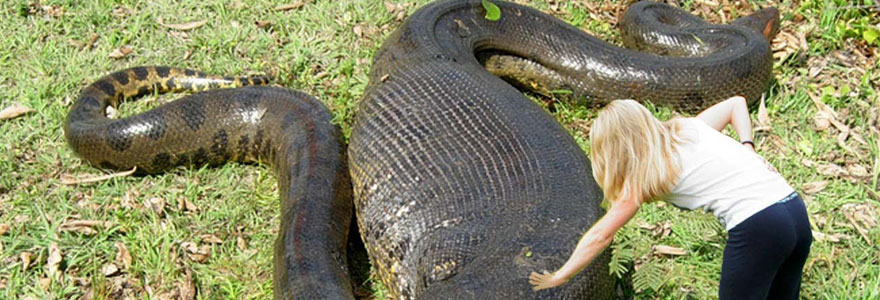The Secret Life of an Anaconda
Anacondas in the wild spend most of their time hanging out in rivers hunting for their food. They are solitary creatures that are somewhat shy and not many of them are easily seen. They are very well camouflaged in the swamps and bogs in which they thrive. There are some historical reports of early European explorers of the South American jungles seeing giant anacondas up to 100 feet long and some of the native peoples of the
South American jungle have reported seeing anacondas up to 50 feet long. No one has caught and measured an anaconda anywhere near that size. It is important to note that when a dead anaconda's hide or skin is laid out it can be stretched very easily, expanding to much longer lengths than the snake exhibited when alive. Reports of outsize anacondas that cannot be verified are usually due to distortions in perception, or a snake skin being disproportionately stretched and inaccurately measured. People are generally really bad at
estimating length, especially for larger snakes. In fact, the larger the snake, the larger the margin of error.
Anacondas like to hang out in rivers so it would be difficult to estimate the length of one seen swimming, without seeing the entire snake. It's the anaconda's ability to remain partly hidden in the water that makes it difficult to accurately find (and document) a specimen that exceeds the current world's record. (Would you want to jump in the water after a giant anaconda to try and measure a snake big enough to kill you?)
Killer Snake
and squeezing until their prey suffocates or is crushed to death and dies from internal bleeding. Then the snake unhinges its jaw and swallows the victim whole. Anacondas are much more likely to eat aquatic creatures, such as fish. Occasionally they have been known to eat: caimans (a relative of the alligator), other snakes, deer, and even jaguars. Anacondas are rather slow-moving snakes, so they have to rely on stealth and the element of surprise to catch their unsuspecting prey.
Do Anacondas Bite?
Just about every species of snake on earth has teeth, but the anacondas' teeth are not used for chewing. Snakes' teeth are used for holding onto their prey, preventing them from escaping. Some snakes have venom in two specially designed, extra long teeth (called fangs) which they use to kill their prey. Anacondas have teeth, but they are not a venomous snake. They rely on their enormous size and power to subdue their victims. It is possible to be bitten by an anaconda, but the bite itself would not be fatal.

